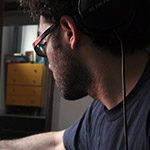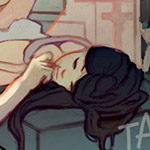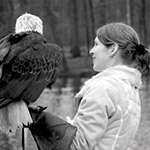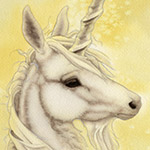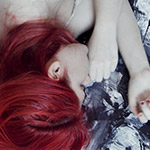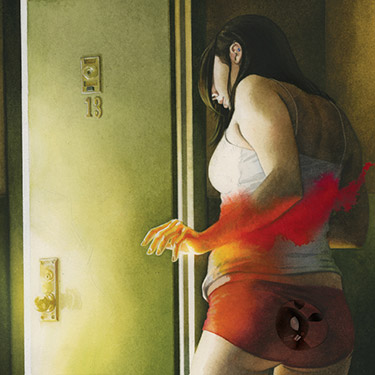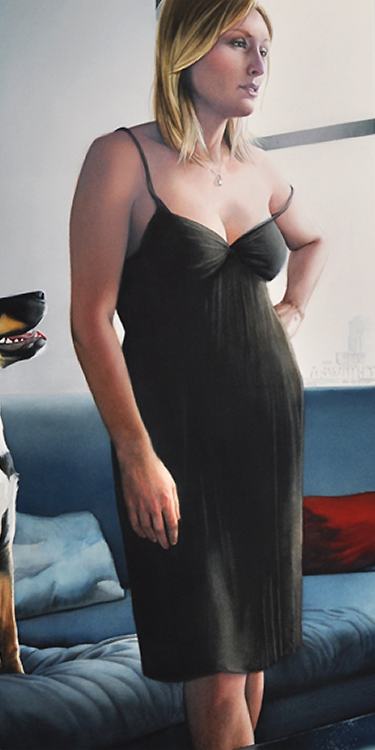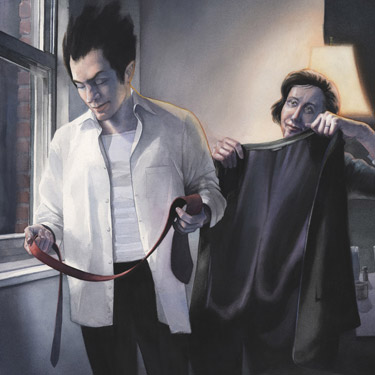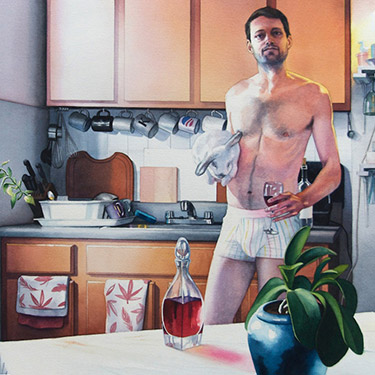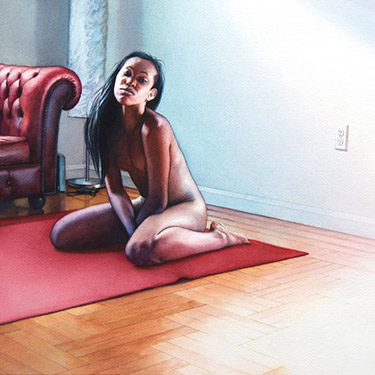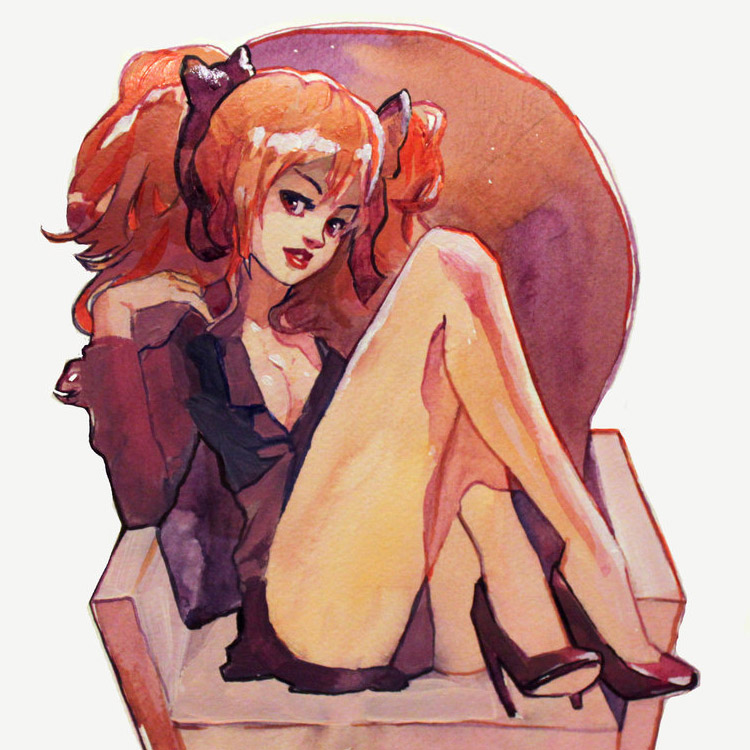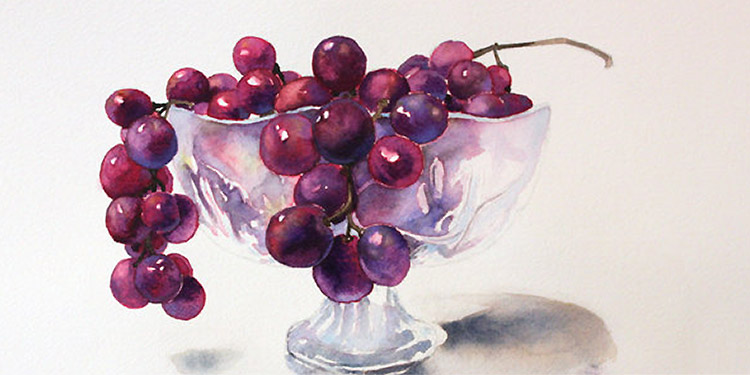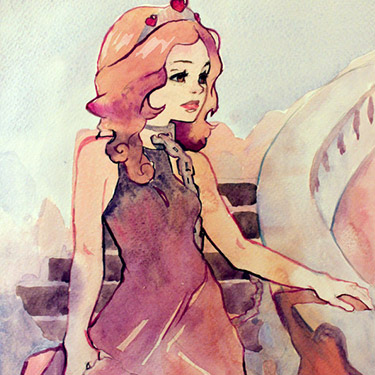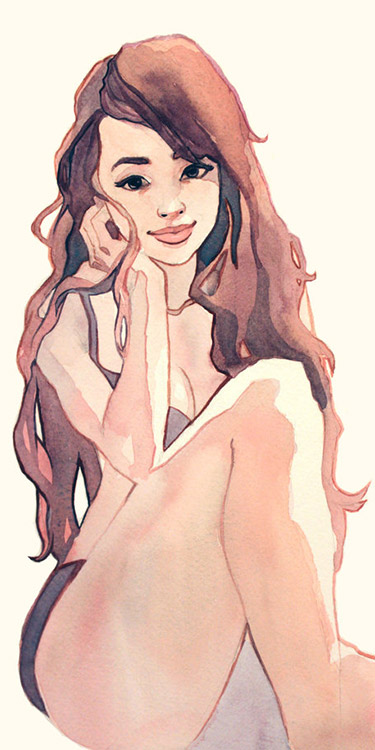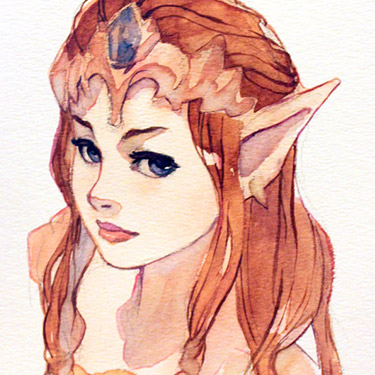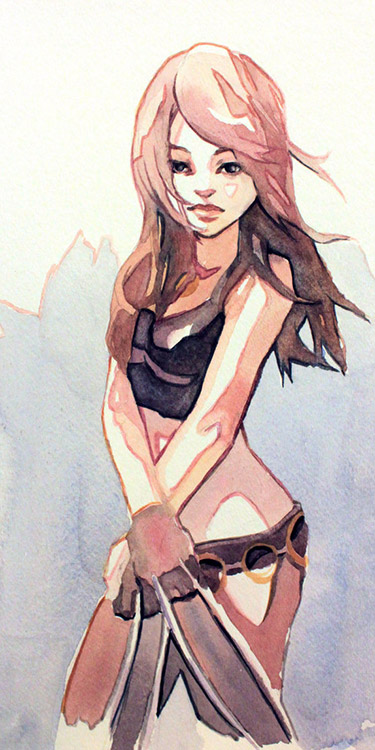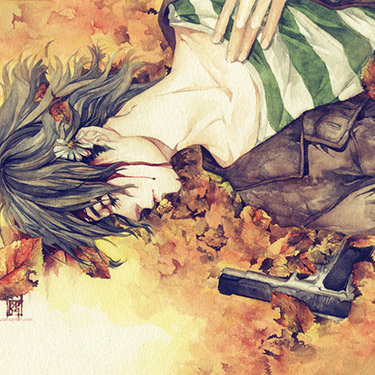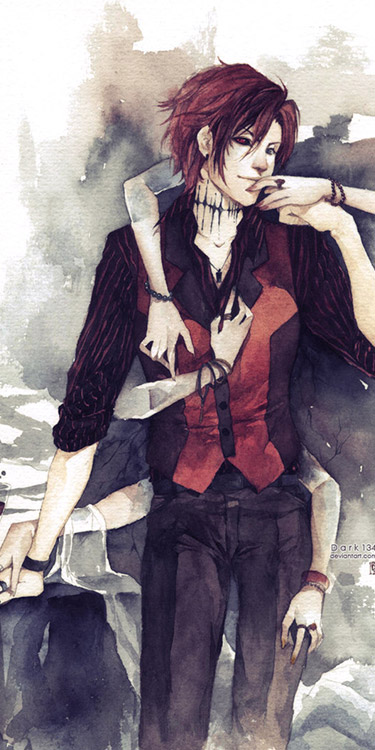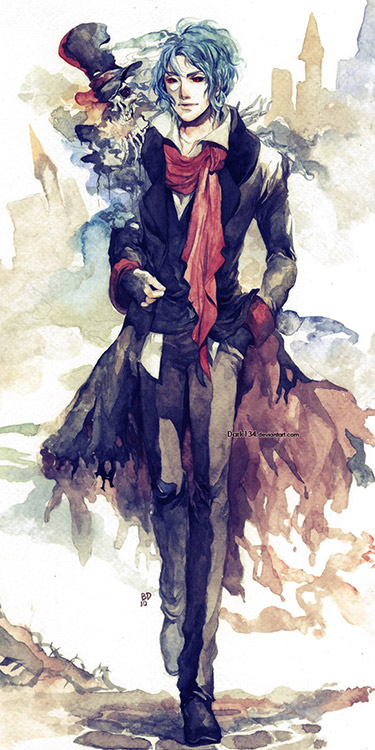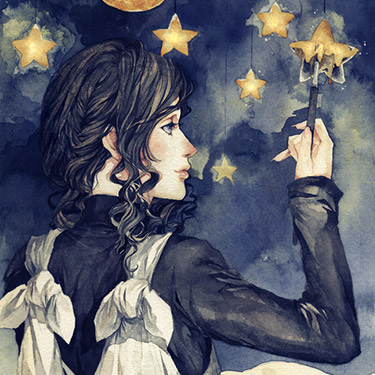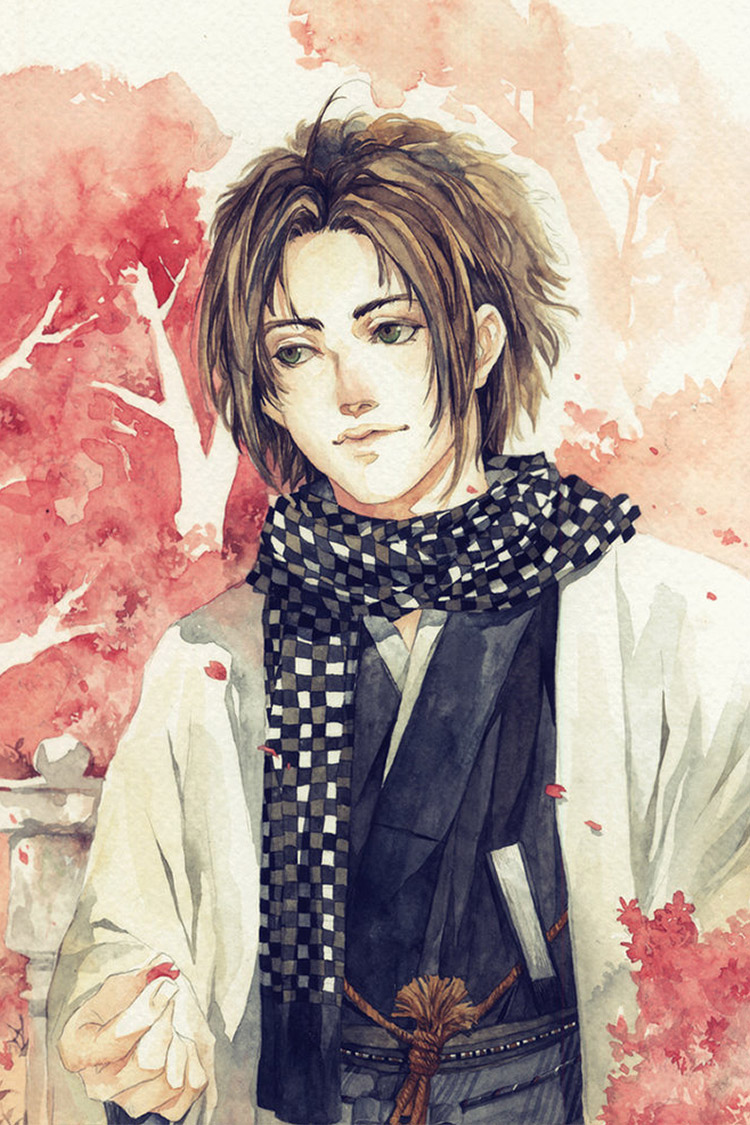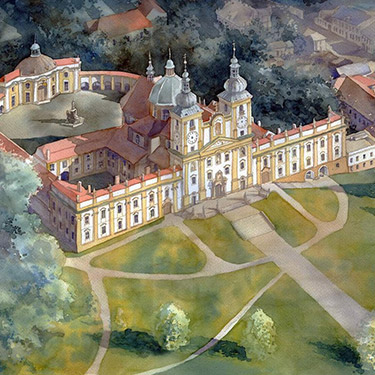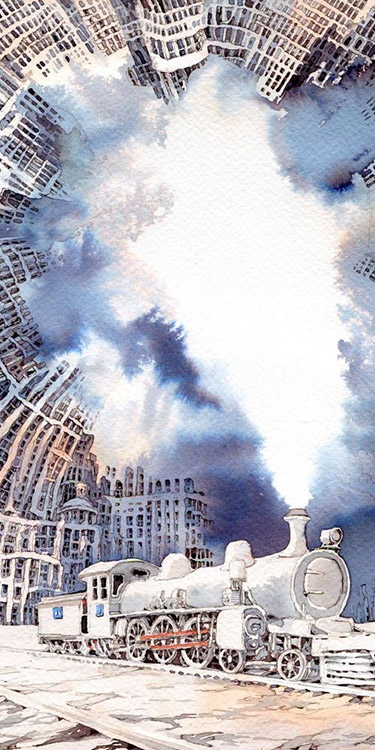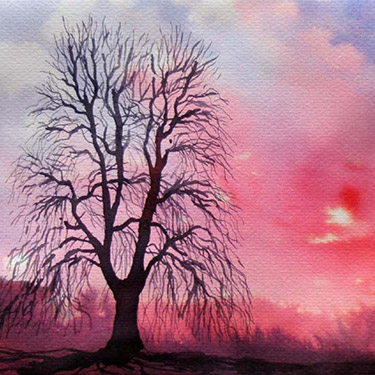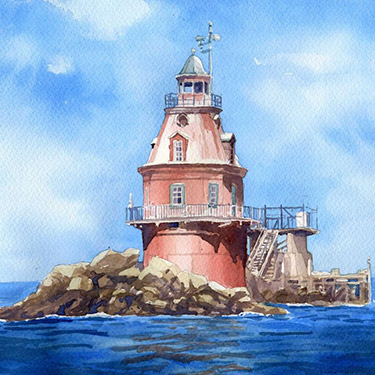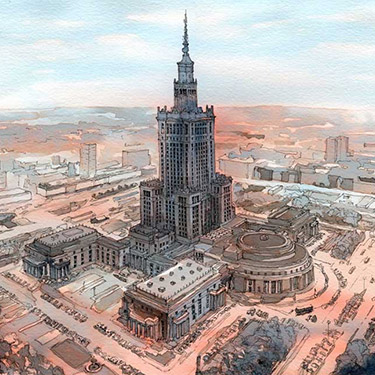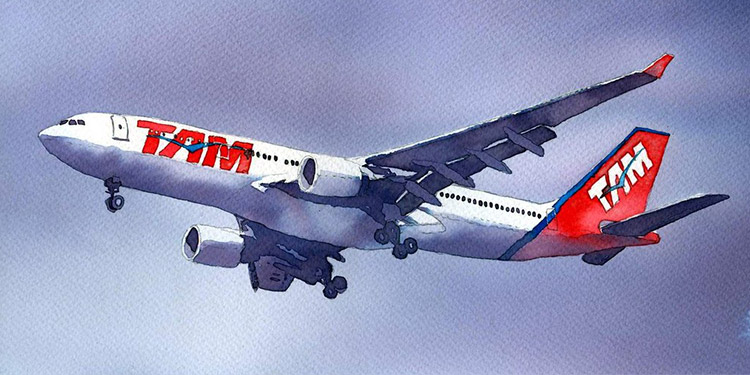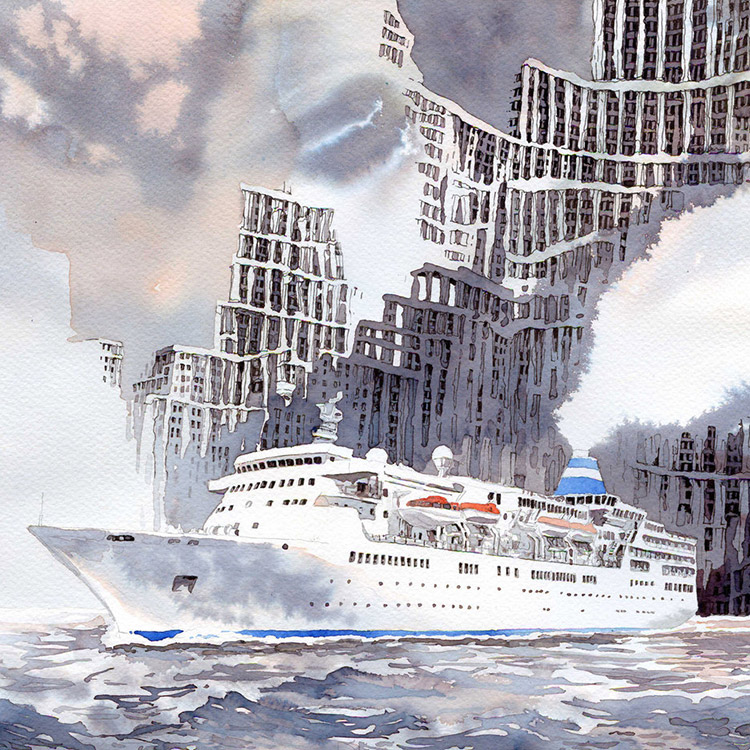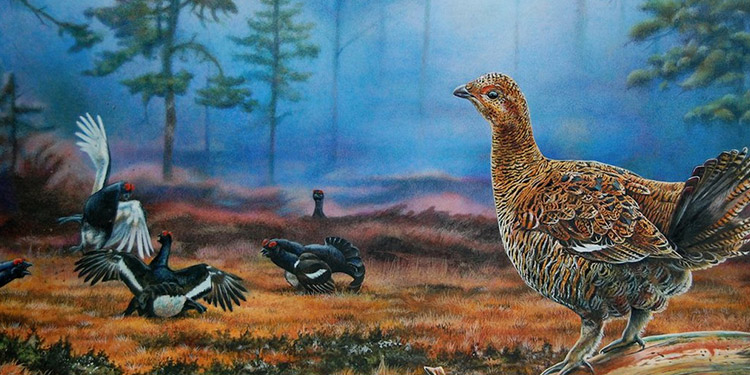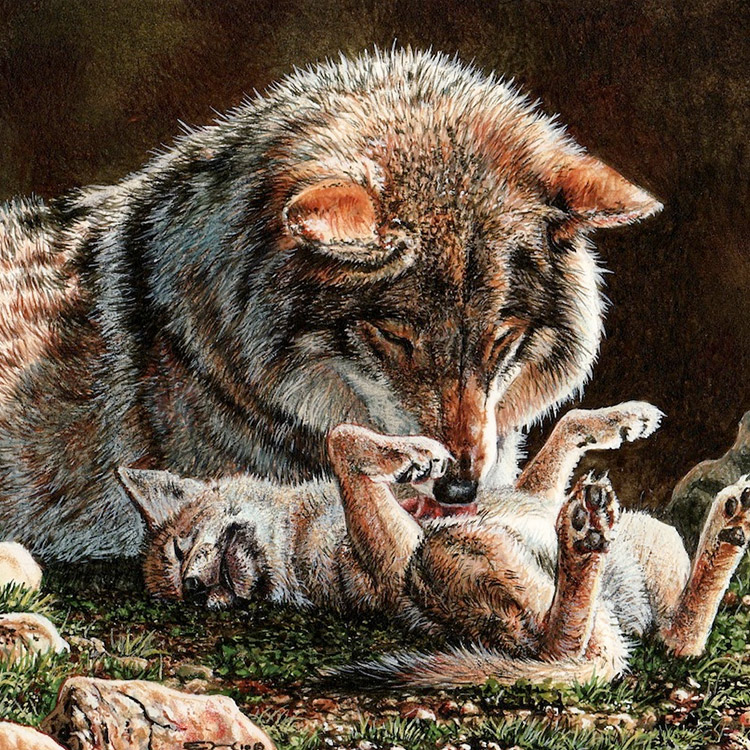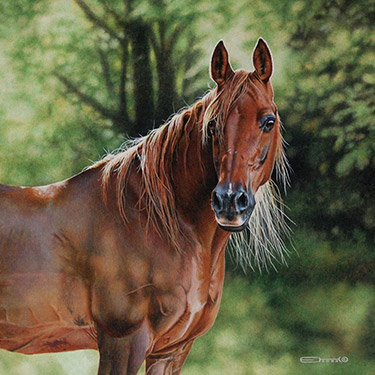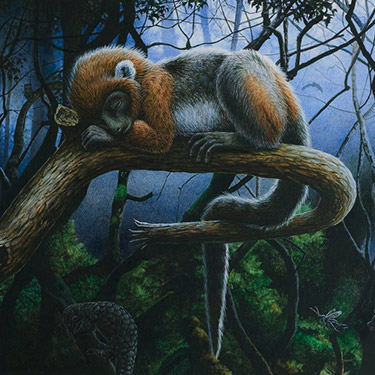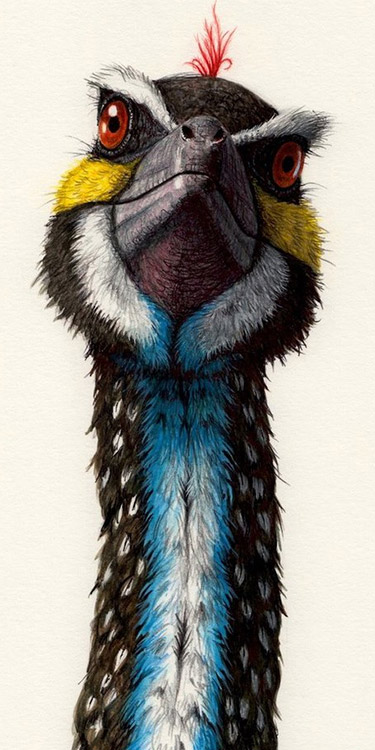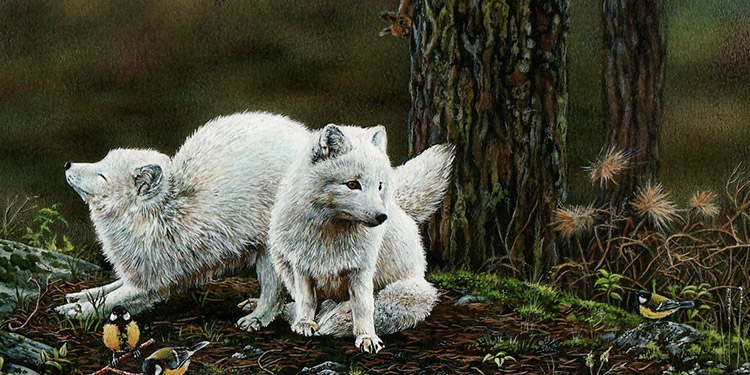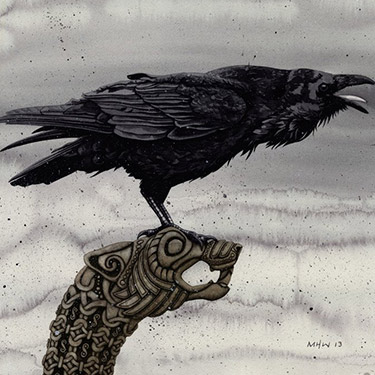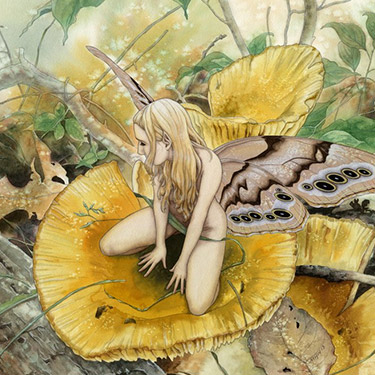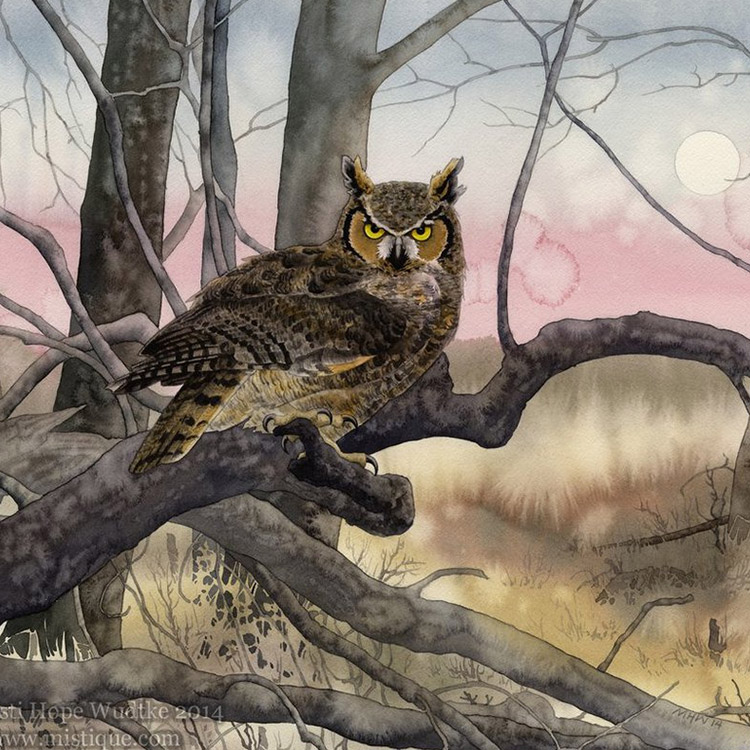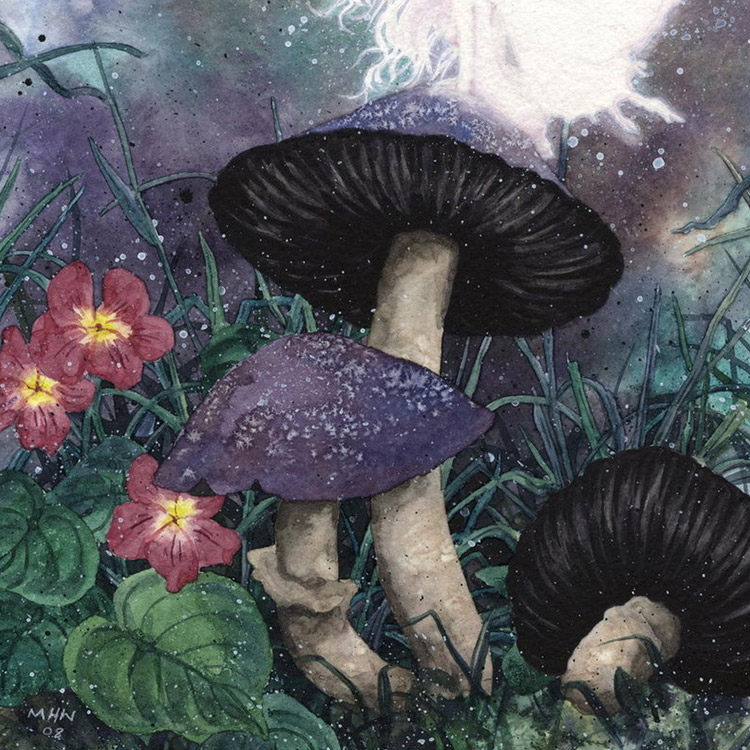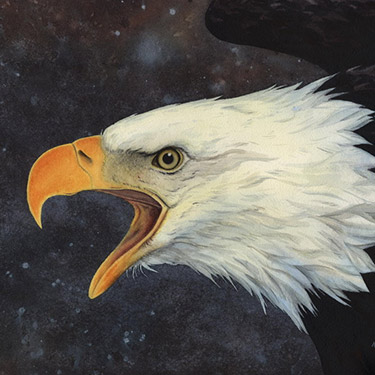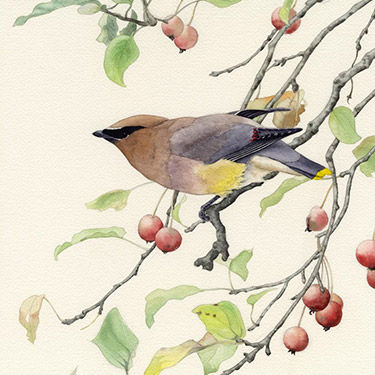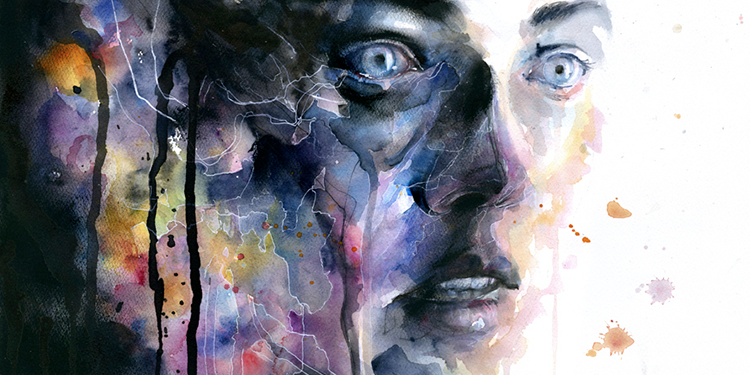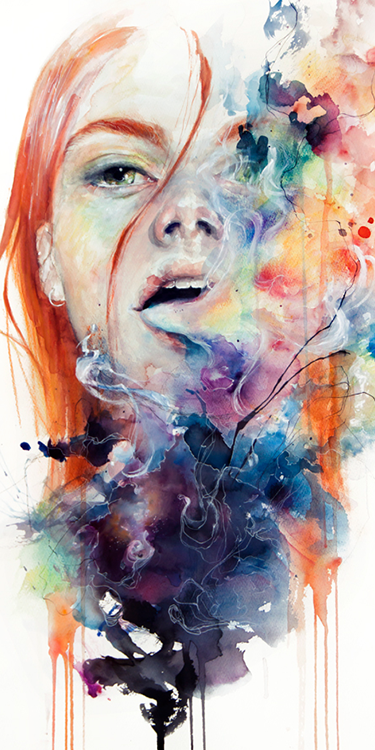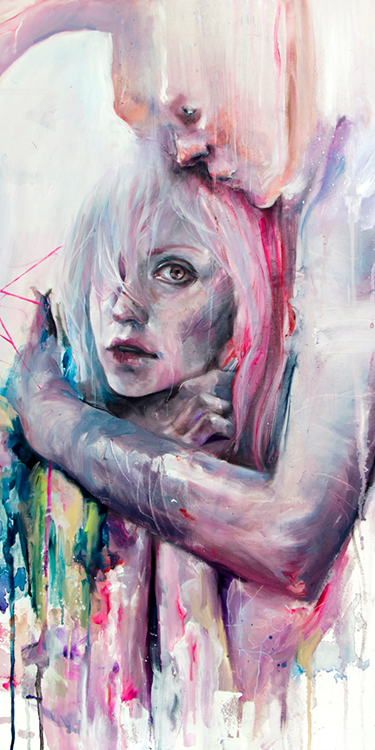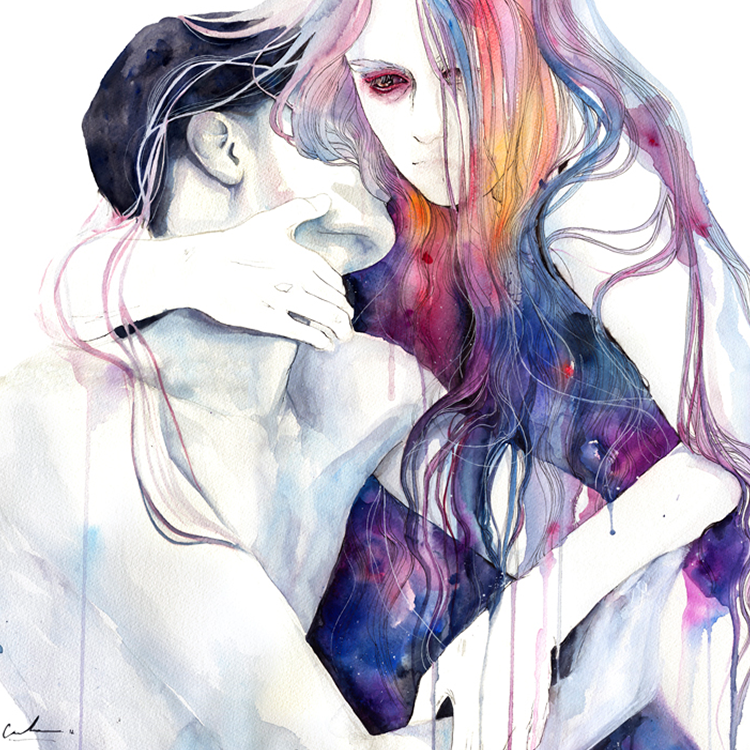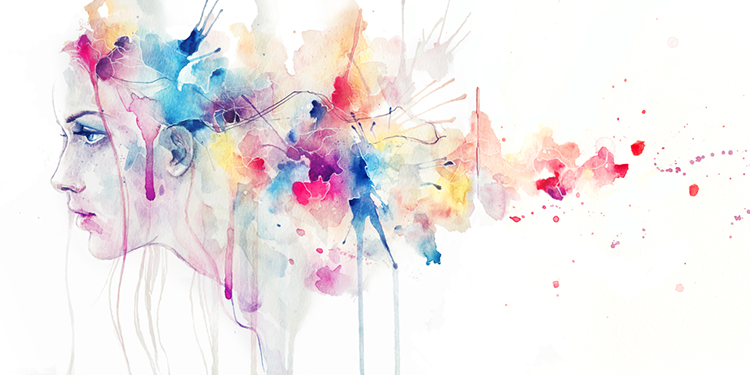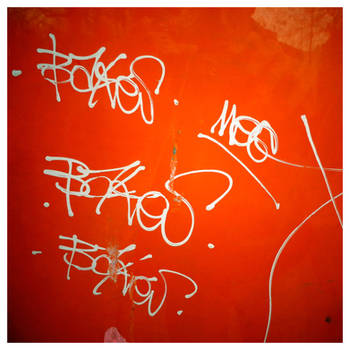Christopher Behrens, the 7-year deviantART member contributing this wonderful history of watercolors to depthRADIUS, along with curating artists and interviews, is a modern renaissance man held in high regard by fans of his unique artistic vision. He is an independent filmmaker, author, and a masterful watercolorist in his own right. His gallery of works can be perused here.
Watercolor by ctbehrens
he history of painting begins with watercolor as it is the oldest painting medium. Ground pigments have been unearthed in Africa dating as far back as 60,000 B.C., and we are all familiar with the Paleolithic cave paintings in Spain and France.


Lascaux Caves containing Paleolithic wall paintings and engravings thought to date Magdalenian times (c13,000–8500)
The Egyptians used water-based paints to decorate their tombs and temples. With the pulp of the papyrus plant they became one of the early adopters of watercolors on paper.
The Chinese have a long-standing tradition with watercolor dating back to 4,000 B.C. It was their developments in paper making production around 100 A.D. that brought about a marked advancement in technique and sheer amount of produced work.
It wasn’t for another 1,000 years before mass paper manufacturing came to Europe, as the Arabs, having learned the basics of papermaking from the Chinese and making improvements of their own, spread the new product to the West—namely Spain, Italy and France.
Lascaux Cave
Artwork (c13,000–8500)
However, for the next several hundred years, watercolor use in the West was primarily used for religious book ornamentation (Book of Kells), and for frescoes as the water-based pigments were applied to wet plaster (Michelangelo’s Sistine Chapel).

The Book of Kells containing the four Gospels of the New Testament, created by Celtic monks circa 800.
In the 1500’s, the first acknowledged master of watercolor, German artist, Albrecht Durer, developed new techniques which showcased the luminous properties achievable with watercolor on paper (Durer’s The Hare.)
Despite Durer’s advances, over the next 300 years watercolor was used mainly as an aid in preparatory sketches for oil paintings, or as a simple medium for wildlife & botanical illustrations, and map-making.
Hare
Albrecht Dürer(1502)
It wasn’t until the late 18th century with the introduction of specially treated and sized papers produced exclusively for the medium that watercolor painting as we now know it gained its prominent place in Western art.
The 19th and 20th century saw a revolution in watercolor techniques, with many modern masters pushing the envelope of this ancient medium.
The artists of the 21st century, many of them here on deviantART continue brilliantly in their tradition.
Mink Pond
Winslow Homer(1891)

We had the opportunity to interview artists from the deviantART community to share their experiences with watercolor.
I prefer to use Arches Cold Press paper, typically the 300gsm weight. I also pretty much exclusively use Winsor & Newton Artist Colors. My brushes vary. I'm a fan of the Raphael Kolinsky brushed but lately Ive been relying heavily on the Escoda Prado brushes. I tend to beat up my brushes so I also like the Winsor & Newton Sceptre Gold series for their affordability and durability.
I've been influenced by a number of artists across several different media. My work is very narrative so I am drawn to anyone that can tell a story or convey a mood. I value empathy over technical skill. Some of my favorites (in no particular order) are Nan Goldin, Andrew Wyeth, Stevie Wonder, Stanley Kubrick, Bernardo Bertolucci, The Talking Heads, Neil Gaiman, John Gardner, Douglas Adams, Dave McKean, Kent Williams, Diego Velázquez, Gregory Crewdson and Tori Amos.
Oddly enough, I started using watercolors out of necessity rather than choice. In college I painted with oils and the fumes from the medium and thinners started giving me migraines so I switched to watercolors to avoid any longterm health issues. I've never looked back.
I love that every time I begin a new piece it's as though I've never used the medium before. Watercolors always present a different challenge—from taking into account the humidity in the air, the quality of the paper, or the complexity of a drawing, to the mineral content of the water or the wear of my brushes... that is always some variable i can't control so I have to be flexible and quick on my toes while I paint. It's controlled chaos.
I think my strength in watercolors doesn't necessarily come from a learned technique but rather a desire to challenge people's perceptions of what a watercolor can be. It's such a beautiful medium but is often regaled to second class status under oils. I enjoy creating dense, opaque watercolors that are often frustrating to create but fulfilling when they demonstrate the versatility of the paint. As for my weakness - Sometimes I wish I had someone standing behind me telling me to stop. I often find myself over-working a painting and then struggling to get back to where I was the day before.
I rarely use masking fluids in my own work but that's a personal choice. The same goes for gouache. Up until very recently I'd regularly employ gouache as pert of my paintings but now it's all pure watercolor. I stopped using them for color and opacity issues over anything else. As for masking fluid - I have from time to time used them but I like seeing the flaws in my work and often try to capitalize on overlaps or drips.
It depends on the size of the piece, complexity of the drawing and the weather. Some can take a few days while others have taken me months. On average I'd say I'm hovering around 2 weeks for a large-scale (40”x26”) watercolor.
Digital art is a tool, not a replacement. It has it's place right along side oils, acrylics, graphite, charcoal and anything else we use to express our selves. I embrace digital art and find it new and fun and intriguing. But it's no threat to traditional mediums.
I get a lot of questions about my technique and tools and I'm also no stranger to discussing the larger, social issues that surround my work. Honestly, rather than being asked questions I love hearing how about others' reactions to my work how it affects them or how they read it. My work is only partial stories that I depend on the viewers to complete. Hearing how each painting is seen by the audience never gets old.
I like Robert Simmons Sapphire series for brushes. Dick Blick and American Journey for Paint. Strathmore for paper, sometimes Arches.
I was late to sign up for an acrylic class and watercolor was the only one left. I like it now, though, so good thing that happened, right?
The ability to spread a lot or a little pigment quickly and being able to use a blowdryer while painting to speed up the process.
I paint fast, I can make small details that others usually use watercolor pencil or pen for. I don't like to state my weaknesses.
I'm a purist. I wouldn't call it cheating, but it should be mentioned and categorized properly.
I'm using some no brand brushes I've bought at my old school, my paintings usually have really small size so I love to use some nails painting brushes. Leningrad watercolors—Daler Rowney/ W&N Cotman paper.
I chose silk-painting to study in university. That was the time I had my chances to see many beautiful watercolor paintings. Watercolor gives me complicated and simple feelings at the same time.
I love to see watercolor most when someone uses it to describe the light. Light in watercolor is so pure. And when the deep in watercolor is made by many many layers, I've lost in that.
I think I have a patience with drawing details. I usually spend a lot of time on some tiny details. I don't know how to use wet effects much. That's really a shame...
Maybe I'm almost a purist. Because I don't use effects much so I rarely use masking fluid but I think we can use any way to creat a painting. I hope I could find a good way to use those tools.
Although Digital Art may rule the world but I don't think digital art could show the artist's emotion better than traditional art. Traditional art always touches viewers's hearts and the artists themselves. So I think Traditional art never could/ should be replaced.
Brushes: No matter, I can show photo of my set - must be not destroyed.
Paints: (1) Koh-i-Noor "brilliant water colours"—very strong colours, red and blue, sometimes orange. (2) Ecoline (talens), 2 colors, Ultramarine and Vermilion. (3) Van Gogh by Talens—"Classic" water colours, standart set, burnt sienna, ultramarine, vermilion, ochre, phtalo blue, celureum. (4) White Nights—Russian artist watercolor, standart set (24 colours box).
Paper: Just watercolor paper, bought as peaces 100x70 cm and then cut to smaller fragments, ussually A3, A4 or A5.
I had some free time when my son was born and i couldn't work as an architect - i had to stay at home and had onle few hours a day to work. All I could do was to draw and to paint.
A. using strong bright colours, which gives strong contrasting effect & B. Weakness... Don't know... I'm at the beginning of my carreer as an artist. I have still a lot of to learn.
I'm not purist masking fluid is not cheating, according to me. It simple gives more options not available if you don't use it. Everything is ok to achieve effect. Even using coloured pencils, ink drawing, transfering details or fragments straight from photo, etc. Cheating is, if you use masking fluid and says you don't, or use a photo and pretend you draw without it.
Plain - air painting, making quick notes, design, early stages of designing, concept drawings, ceating unique art (not mass prints.) I think one should join elements (advantages) of digital and traditional art. For example, as an architect sometimes i have to create a view of designed building, for architectural competition etc. I think it's better to create simple 3D virtual model, print it and then to color it using water colours, than to make photorealistic rendering using only computer.
Carl Brenders, James Gurney, Terry Whitlatch, Joe Weatherly, Co Loerakker and Edward Aldrich.
It is a very friendly medium to work with. No toxins, which are bad for the environment and health. It dries fast, and one can "push and pull" after the paint dries. It also lends itself very well to use colored pencils on top.
The fact that you can push and pul the paint after it dries. One also has to work purposely, there is only a limited amount of layers one can apply before the painting starts to look muddy.
I use some colored pencil in addition. And take the most out of the medium when it comes to detail.
Absolutely no problem. It is important to save the white areas on the paper, because white does not et whiter that the white of the paper, but I also use gouache on top.
Depends on the size. Tiny paintings can be done within a few days. Larger works can take up to two months.
I think that Digital Art is just a new medium, added to all the other mediums that were already there. It is a new way of making art, but it is not better or worse that more traditional mediums. It is just another medium to choose from.
Escoda brushes (Toray Gold, round), Winsor & Newton watercolors (basic palette, primary colors) and Arches cold press 140 lb paper.
Gustav Dore, Arthur Rackham, John Bauer, Theodore Kittelsen, Brian Froud, Jean Baptist-Monge, Susan Seddon Boulet, Jody Bergsma, Stephanie Pui-Mun Law and a BOATLOAD of other fabulous deviantART artist.
I think I've always just loved the "look" of watercolors. More than any other medium, I think, a watercolor painting is instantly recognizable as such. I love the effects one can achieve with water, salt, etc., what texture and distinction can be gained by just letting watercolors "do their thing". And, of course, paintings don't take months to dry, and I don't have to trash used paint that's dried out.
Oddly enough, my favorite thing about watercolor is what an unforgiving medium it is. For the most part there is no "Undo" button. Even with such traditional mediums as oils and acrylics, mistakes, and things you'd just rather not have done, are fixed relatively easily. I suppose I feel this gives anyone who's really good with watercolors a bit of a prestige boost, and it also forces me to not exercise my unflagging OCD-ness. Once it's done, it's done, and there's no going back.
Haha, I'm still working on that! I think that, what I try to achieve in my paintings (not to say that I always get there) is the impression that they were painted by someone who not only looked, but *saw*.
I may have to explain that. I see a lot of paintings whose backgrounds include e.g. trees, mountains, flowers, etc. And the artist thought, "I know what a tree looks like; this is easy. And he draws a tree. Or what he thinks a tree looks like. Often the result is simple, even a little childish, and looks very much like an afterthought on which the subject was unceremoniously hung. If the subject is taken away, the background looks no better than scaffolding.
When I sketch, I look at everything. What does a curled-up autumn leaf *really* look like? Or mushrooms? Branches, trees? My aim is that, if the subject of the painting was taken away, its setting would still look plausible, and would moreover be enjoyable in and of itself.
As for a weakness: obsessing too much over the details I love. And bad anatomy.
I used to use both masking fluid and gouache a lot more than I do these days. If I can avoid using them I will. But I don't considering myself a purist. To me, more important than what materials I did or didn't use is the effect achieved, and if I have to stoop to gouache to get it, so be it.
Starting from scratch, including the drawing/sketching phrase, anywhere from two to seven days. Longer if I procrastinate.
I made a digital painting or two back in the day. When I first acquired a tablet no one was more excited at the prospect of digital art than me. But for some reason digital art has lost its shine in my eyes. Maybe I'm just getting old (-fashioned), but nowadays I like to see a painting whose maker got his/her hands dirty. I like to imagine the texture of the paper/canvas of the original. I like to know brushes were wet, palettes were besmirched, and strokes were made whose author couldn't take them back with the click of a button. I like to know that, somewhere in the world, that painting *exists*.
Although there's a lot of amazing digital art out there, I'd like to think there will always be a place for art made and appreciated by people who feel the way I do. I know a lot of work goes into making an outstanding digital painting, but I'd like to think there will always be those who appreciate art created in the absence of an "Undo" button.
Don’t be discouraged if your first attempts don’t turn out the way you wanted. If they do turn out the way you wanted, I want your secret. Practice. Practice practice practice. Paint things you've never painted before. Paint things you're afraid of painting. Be fearless: watercolors are not for the meek. Don't avoid painting something you really want to paint because you think you're not good enough yet. You can always do it over. You'll never be as good, in your own eyes, as you think you ought to be. Don’t think, “This turned out horribly.” Think instead, “I learned so much from this; I’ll do much better next time.” Then start on next time.
My paintings talk about feelings, each emotion is like an inner energy needing to have a form on paper, these explosions and implosions are the shapes of this strong invisible but concrete aspect of inner life. But to express different moods, I use different techniques too, the evolution of tools is important to be able to work with a diverse array of feelings. Sometimes this energy is inside, sometimes it needs to go outside, sometimes it's more violent and other times is more sweet.
Watching how a painting is born helps to better understand it, the story behind it. Often the little fight between the canvas and the artist is more relevant of the canvas itself, the relationship with the work is just there. I should make more videos! but it takes me a lot of time.
Often I have some imaginary figures in my mind. I give life to some characters that help me to talk. So, they are no one in particular and also someone in my mind too. I never use friends or similar subject matter in my works, I prefer unknown characters where I find different aspects of me.
Yes, of course. As I mentioned, my paintings are a page of a diary, all of the time there is something big that burns inside my chest, I need to put it on paper, I’m quite uncomfortable to write or talk in these moments, painting helps me to find solutions to my troubles. It’s without doubt a therapy. Often my paintings speak more than me!
Don't think in those terms, stop spending hours just looking at other artists and take a little more time with yourself. All of these outside images could smother you. It's ok to throw a lot of drawings out when you are learning and just starting out. This is normal. Keep spending the most time on what you love, firstly for yourself, then you will start to receive the rewards of your hard work and also receive many a “bravo!!” if there is a deep passion within you, everything comesnaturally!
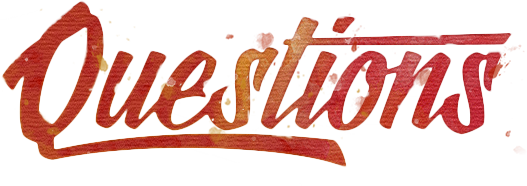
For the Reader
- Should every artwork be judged and appreciated for its creative impact, emotional/spiritual appeal and sheer beauty regardless of the production medium?
- Are there digital artworks being produced currently that you have found to be every bit as engaging, satisfying and catharsis-producing as your most beloved watercolor (traditional medium) favorites?







